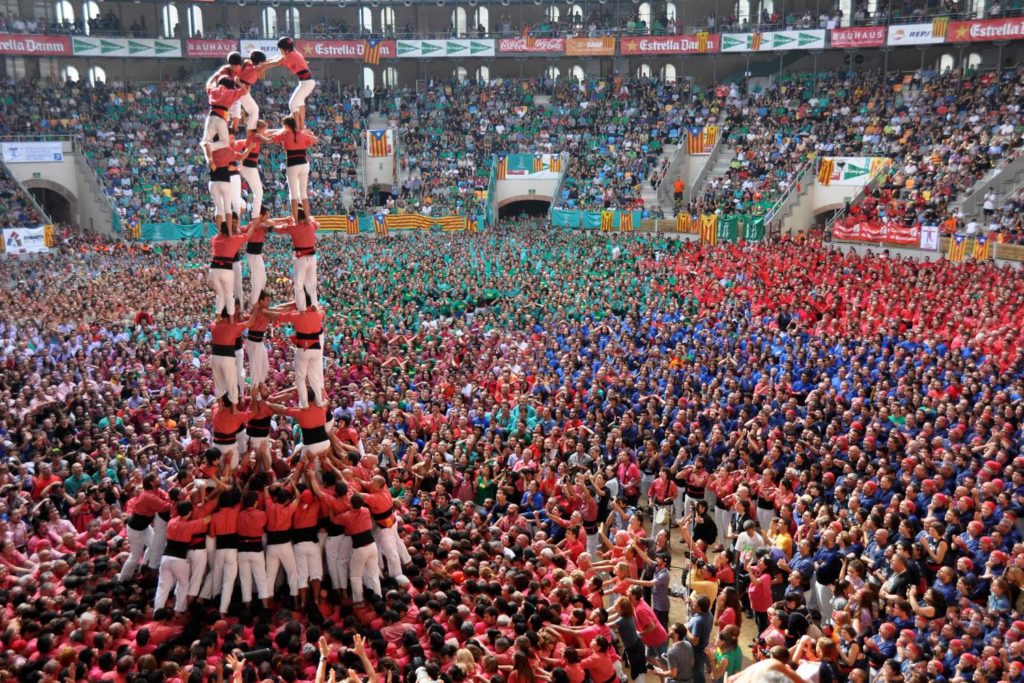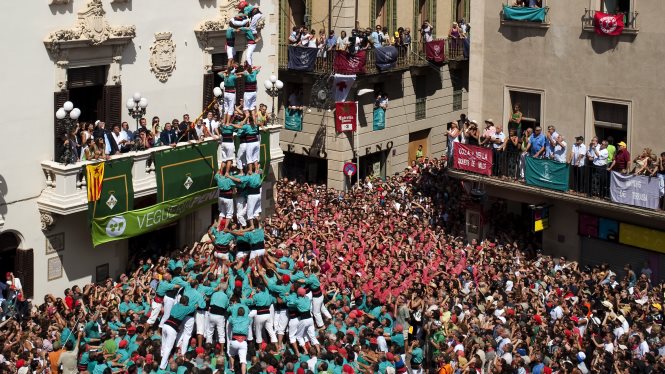Castells, or human towers, are one of the symbols of Catalonia. In this article we’re going to tell you a little bit more about their history and how they have become so popular today, not only in the region, but also around the world.
Chances are if you’ve spent some time in Barcelona or Catalonia, you may have come across these simply breath-taking towers built by castellers with their bodies, by climbing up each other’s backs and standing on the shoulders of the person below.

Table of Contents
The history of castells
Despite the origin of castells – meaning castle in Catalan – being slightly unclear, it is thought that they come from similar, smaller structures erected at the end of traditional dances – specifically the Valencian dance from the 15th century.
However it wasn’t until much later, in 1801, that the first castell was documented in la Candela, Valls (Tarragona). It was here that they were first built with the aim of constructing original and increasingly taller human towers, and not as part of a dance. From this moment on, these mind-bending structures became an essential part of local celebrations and festivals.
It wasn’t until the late 20th century that this tradition truly began to be recognised in all its glory. Unlike other Catalan customs, like the traditional dance the sardana and the Catalan flag and national anthem, castells were not prohibited during Franco’s reign.
It was in the 90s that it became more commonplace to find castells and colles (community groups of castellers who practice castells) throughout the whole region of Catalonia and over a decade ago, in 2020, they were recognised as intangible cultural heritage by UNESCO.
So, what makes castells so special?
Over the years castells have become ever more complex, reaching heights of up to 10 people. Anyone can take part – men, women and children over the age of 5 of varying strengths, heights and sizes – but it’s certainly not for the faint hearted. Extensive training sessions are required.
In fact, nowadays a total of 13,000 people in Catalonia call themselves castellers and there are over 100 colles castelleres.
To explain exactly how these towers are built, we’ll need to brush up on our castells vocabulary!
The base of the tower is called the pinya. Arguably the most important part of the tower, it holds its entire weight and will absorb the impact of any falls. Next comes the tronc, or the trunk, which is the main body of the tower, formed by two to five levels. The heavier castellers are at the bottom and the lighter, more agile nearer the top.
On top of the tronc sits the pom de dalt – literally the upper part. It is formed mainly by children, wearing safety helmets. And finally, on the very top goes the enxaneta: a young child who climbs the entire structure to the summit and raises his or her hand for the tower to be considered complete.
However for the castell to be considered valid, it must be taken down slowly without anyone falling. The leader of the group – known as the cap de colla – who has perspective over the entire structure from the ground, guides the castellers through the entire construction and deconstruction.

What else do I need to know about castells?
To accompany this wonderful sight and, more importantly, to mark the rhythm and coordination of the entire structure, live music is played as the castell is built. This particular music is called the toc de castells and is played by gralles – a Catalan type of flute– and timbals, a percussion instrument.
You’ll also realise that the casteller uniform is very important. Each group wears a shirt of a specific colour with an embroidered crest of the city or village to which they belong.
Where can I see castells?
Now you know all about them, we bet you can’t wait to see one in action. The good news is that at almost any local festivity or celebration, you’re sure to catch one of these towers being built.
Castells are normally constructed in main squares in front of the town hall. Some of the best can be seen during Barcelona’s festa major, Sant Jordi or the upcoming day of La Mercè.
Despite castells being recently approved by the local government, with a maximum duration of 15 minutes, this year’s day of La Mercè will see a condensed format of this tradition on Passeig de Gràcia on 24 September at noon, in line with COVID-19 restrictions.